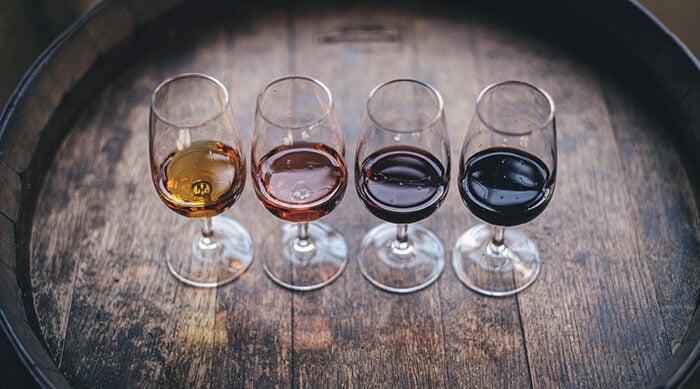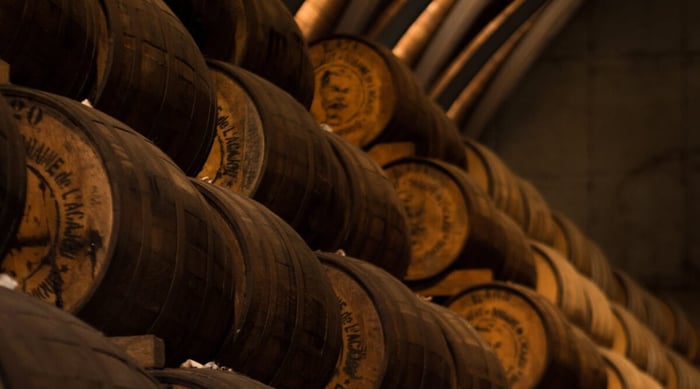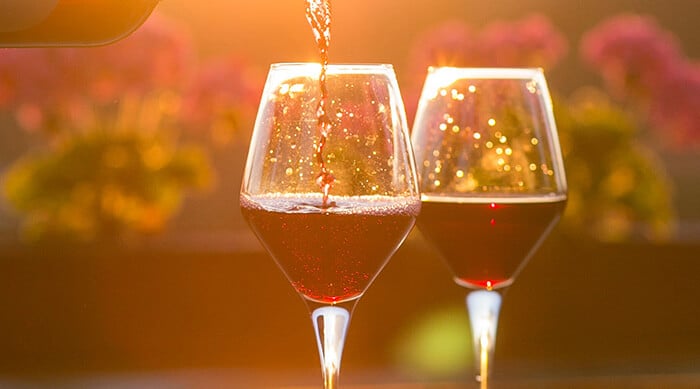You may have heard that nothing ages better than a fine wine. In reality, wine is just like anything else: it has an expiration date.
Wine can go bad, even if you haven't opened it yet. How long a wine can go before it spoils depends on the type of wine you’re drinking and how it’s stored, but no wine is immune to spoilage.
Spotting a bad wine and keeping your wine from going bad is good information to add to your wine basics.
How long does an opened bottle of wine last?
How long an opened bottle of wine lasts before it goes bad depends on the wine. Here’s a cheat sheet:
- Sparkling wine: 1-2 days
- Rosé wine: 4-5 days
- Light white wine: 4-5 days
- Full-bodied white wine: 3-5 days
- Red wine: 3-6 days
- Dessert wine: 3-7 days
- Fortified wine: 1-3 weeks
Fun fact: Boxed wine can last for up to 6 weeks after opening before going bad. Oxygen is a wine’s worst enemy when it comes to spoilage, and those bags inside a box of wine keep oxygen out better than even the best wine stoppers.
How long does an unopened bottle of wine last?
The shelf life of an unopened bottle of wine is much longer.
How long is unopened wine good for? How long an unopened wine is good for depends on the type of wine and how it is stored. For example, a vintage sparkling wine stored correctly can last up to 10 years.
Here are a few more timelines for how long you can keep unopened bottles of wine:
- Rosé wine: 1-2 years
- White wine: 1-2 years
- Red wine: 2-3 years
- Sparkling wine: 3-4 years
- Fortified wine: 10-20 years
Some wines have an expiration date printed right on the bottle. If your bottle doesn’t, check the vintage date. If it’s a red wine, a good rule of thumb is to drink it within 2 years of the printed vintage date. For white wine, add one year.
Why does wine go bad?
A few things are happening when a bottle of wine is opened. Exposure to air leads to oxidation, which affects the wine’s integrity and turns it stale.
Another chemical reaction comes from the wine’s exposure to bacteria that turn alcohol into acetic acid. These acetic acid bacteria (AAB) are behind the vinegary taste and smell of a wine that has obviously gone bad.
Improper wine storage can accelerate these chemical processes.
Here’s how you can tell if your wine has gone bad
How do you know if wine has gone bad? The color, smell, and taste are a few things to look for if you think your wine has gone bad.
Color
Pay attention to the color of your wine after you first open it. Any changes in that color can mean spoilage.
A bright red pinot noir can become darker and bolder; purple-hued reds like cabernet can take on a brownish tint. A white wine that takes on a more yellow or brassy, straw-colored hue has likely gone bad.
Smell
Taking a big whiff of wine isn’t all for show at a wine tasting. It will let you know whether there were any issues during the fermentation process. If your wine smells of rotten eggs or cabbage, that can mean it didn’t get enough oxygen in fermentation.
A wet dog or wet cardboard smell may mean your wine is “corked.”
Corked wine, or cork taint, happens when a molecule known as 2,4,6-trichloroanisole (TCA) sneaks into wine during the winemaking process. TCA is most commonly found in corks, but it can also transfer to wine through wine barrels.
If you think your wine is corked, there is a hack to eliminate some of that funky smell – that isn’t pouring it down the drain.
Pour the entire bottle into a bowl or pitcher with wadded-up plastic wrap at the bottom. The wrap acts like a sponge for the TCA. Swirl the wine around for a few minutes. Decant the wine into a new container. Your wine won’t taste perfect, but the offending odors should be gone.
That’s all related to unopened bottles, though. If your wine has been sitting out for too long, you should look for different smells.
Wine can start taking on a sharp vinegar smell, like sauerkraut or a damp barnyard smell. Stale wine can smell nutty, even a little burnt, like a marshmallow that was toasted a bit too long. Some compare the aromas to applesauce.
While drinking wine that smells like a campfire snack may sound good, it probably means your wine has gone bad.
Appearance
Unless you’re drinking sparkling wine, your still red and white wine shouldn’t have bubbles. If it does, that means another round of fermentation has occurred inside the bottle.
You should also examine the cork on a bottle of wine before opening it. If it’s come loose or you notice any leakage, the wine inside has probably gone bad. This can happen because of faulty bottling or extreme temperature changes during the delivery process.
Taste
You’ll likely be able to smell a wine that has gone bad, but if you truly want to make sure a wine has spoiled, a taste test will do the trick.
Bad wine will likely taste sour and sharp. It can have a strong vinegar, even chemical-like taste. Once you’ve tasted a spoiled wine, by the way, you’ll know it isn’t just your palate, especially if you’ve tested with the rest of your senses.
What happens if you drink spoiled wine?
If you ignore all of your senses and drink spoiled wine anyway, it likely won’t harm you in the physical sense. (You may associate that wine varietal with that bad taste in your mouth, though.)
Can you get sick from drinking old wine? Drinking old wine probably won’t make you sick. It’s possible that there may be foodborne pathogens hiding in a glass of bad wine, but the chance of coming down with food poisoning from bad wine is rare. It’s more likely that the experience will be unpleasant than harmful to your health.
Some winemakers have turned to adding more preservatives to extend the shelf life of wine. This includes sulfites, a common preservative that is both an additive to wine and naturally occurring in the winemaking process.
The Best Way to Store Wine
Once a bottle of wine is opened, preserve the quality of the wine by re-corking the bottle as soon as you’re done pouring, refrigerate the bottle, and keep it upright. Yes, you can store an opened bottle of red wine in the fridge, especially if you’re only doing so in between pours.
If you’re not able to get the cork back in the way it came out, a wine stopper is a good option.
What is the best way to store wine? The best way to store wine that hasn’t been opened is to protect wine from temperature changes, humidity, and too much movement.
You don’t need a wine cellar to store wine properly. Follow these tips:
- Keep your wine horizontal. Choose a wine rack that will keep your wine bottles on their side. This keeps the cork from drying out. A dry cork allows more oxygen into the bottle. (If your wines are screw tops, though, you can store them upright.)
- Limit movement. We hope you’re not shaking your bottles of wine around just for fun. Treat a fine wine with respect to preserve its integrity. If you want to show off a vintage, do so gently. You don’t want to dislodge the cork and start the oxidation process.
- Monitor temperature changes. Choose a cool, dark place so you can store your wine at a consistent temperature, ideally around 55° F. If you’re thinking about storing multiple bottles of wine over time, a wine fridge will keep your wine at the ideal temperature.
- Consider humidity, too. If you live in a very humid place, use a dehumidifier to keep some moisture out of the air. The ideal humidity range is between 50-80 percent for wine storage. That’s relatively easy to execute unless you live somewhere with extremes.
Should you try to age your wine?
Wine that is sitting out on store shelves is meant to be enjoyed shortly after purchase. In fact, the vast majority of wines should not be aged beyond what the label suggests.
If you’re picking up a bottle of fine wine for a special occasion down the line, some varietals are better suited for aging than others.
Choose a wine that is high in tannins, like a cabernet sauvignon or Sangiovese. Red wines are higher in resveratrol content, too, and generally better for you.
A wine with high alcohol content, like port or other fortified dessert wines, is another good option. Some fortified wines can last for decades before going bad. (A higher alcohol content means watching your serving sizes, though, especially if you’re a woman.)
Note: We’re assuming you’ve read our tips on wine storage to prevent oxidation and cork mishaps if you’re trying to age your wine.
You also shouldn’t freeze your wine. Wine isn’t a big fan of temperature changes, and it isn’t worth the mess if the cork in your wine is forced out of the bottle during freezing.
Does wine go bad when you freeze it? Wine might not go bad if you freeze it, but you aren’t preserving the flavor that way.
If you’re simply trying to chill your wine rather than freeze it, use an ice bucket or a couple frozen grapes in your glass instead.
Real wine so good it will never go to waste.
As more people are being mindful about drinking, more bottles of wine are likely going unfinished. It’s just not healthy to drink too much wine in one sitting, even if that means those opened bottles may go to waste.
If you’re sipping on non-alcoholic wine, you don’t have to worry about moderating your drinking. You don’t even have to worry about the wine calories.
Surely non-alcoholic wine like our bold non-alcoholic cabernet sauvignon comes with zero guilt and all of the flavor. You don’t need to cut back on wine if you’re cutting back on the alcohol with Surely.




